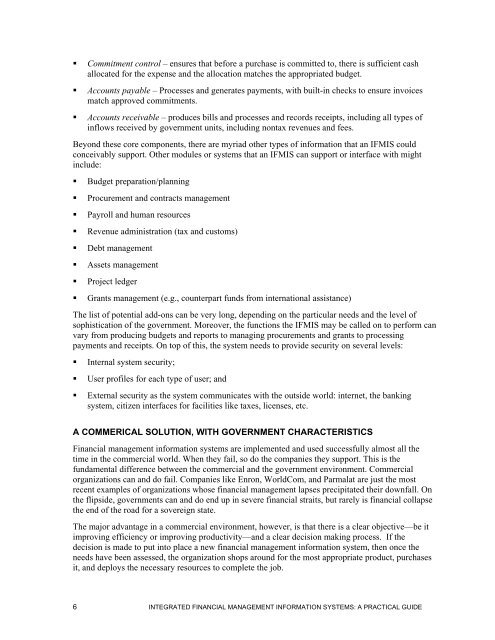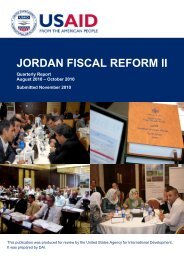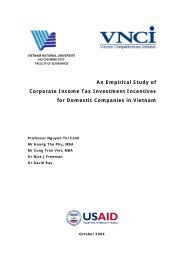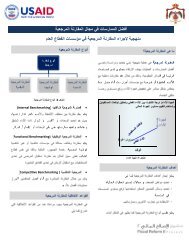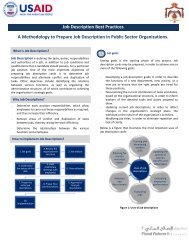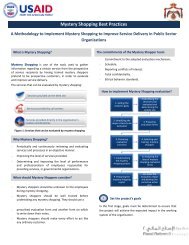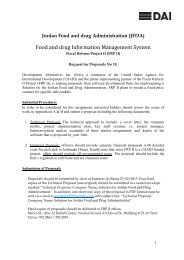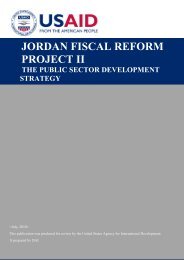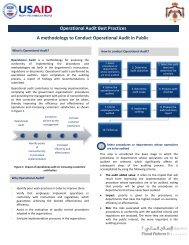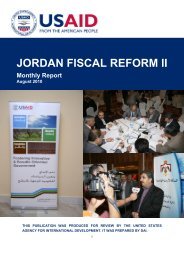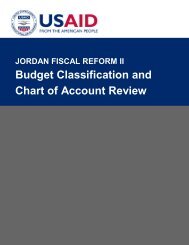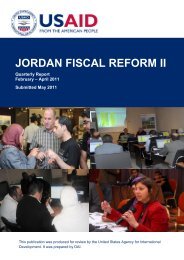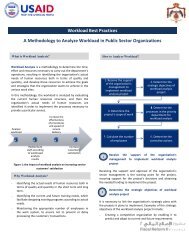Integrated Financial Management Information Systems: A ... - Frp2.org
Integrated Financial Management Information Systems: A ... - Frp2.org
Integrated Financial Management Information Systems: A ... - Frp2.org
You also want an ePaper? Increase the reach of your titles
YUMPU automatically turns print PDFs into web optimized ePapers that Google loves.
Commitment control – ensures that before a purchase is committed to, there is sufficient cash<br />
allocated for the expense and the allocation matches the appropriated budget.<br />
Accounts payable – Processes and generates payments, with built-in checks to ensure invoices<br />
match approved commitments.<br />
Accounts receivable – produces bills and processes and records receipts, including all types of<br />
inflows received by government units, including nontax revenues and fees.<br />
Beyond these core components, there are myriad other types of information that an IFMIS could<br />
conceivably support. Other modules or systems that an IFMIS can support or interface with might<br />
include:<br />
Budget preparation/planning<br />
Procurement and contracts management<br />
Payroll and human resources<br />
Revenue administration (tax and customs)<br />
Debt management<br />
Assets management<br />
Project ledger<br />
Grants management (e.g., counterpart funds from international assistance)<br />
The list of potential add-ons can be very long, depending on the particular needs and the level of<br />
sophistication of the government. Moreover, the functions the IFMIS may be called on to perform can<br />
vary from producing budgets and reports to managing procurements and grants to processing<br />
payments and receipts. On top of this, the system needs to provide security on several levels:<br />
Internal system security;<br />
User profiles for each type of user; and<br />
External security as the system communicates with the outside world: internet, the banking<br />
system, citizen interfaces for facilities like taxes, licenses, etc.<br />
A COMMERICAL SOLUTION, WITH GOVERNMENT CHARACTERISTICS<br />
<strong>Financial</strong> management information systems are implemented and used successfully almost all the<br />
time in the commercial world. When they fail, so do the companies they support. This is the<br />
fundamental difference between the commercial and the government environment. Commercial<br />
organizations can and do fail. Companies like Enron, WorldCom, and Parmalat are just the most<br />
recent examples of organizations whose financial management lapses precipitated their downfall. On<br />
the flipside, governments can and do end up in severe financial straits, but rarely is financial collapse<br />
the end of the road for a sovereign state.<br />
The major advantage in a commercial environment, however, is that there is a clear objective—be it<br />
improving efficiency or improving productivity—and a clear decision making process. If the<br />
decision is made to put into place a new financial management information system, then once the<br />
needs have been assessed, the organization shops around for the most appropriate product, purchases<br />
it, and deploys the necessary resources to complete the job.<br />
6 INTEGRATED FINANCIAL MANAGEMENT INFORMATION SYSTEMS: A PRACTICAL GUIDE


